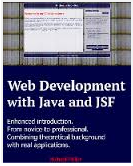JavaEE 7
Client API for JAX-RS API is useful to access the RESTful web services. Basic
steps:
- Get the instance of javax.ws.rs.client.Client class (entry point for invoking RESTful web services).
- Create an instance of javax.ws.rs.client.WebTarget using the instance of Client class (used to invoke a RESTful web service at some location or URI).
- Populate the target with the required data (e.g. MIME type, post data, query parameters), and create a request of appropriate HTTP method type which would be an instance of javax.ws.rs.client.Invocation.
- Obtain the response from the desired RESTful web service via javax.ws.rs.client.Invocation object.
Let's
suppose that we have the following JAX-RS resource:
import
javax.ws.rs.Produces;
import
javax.ws.rs.GET;
import
javax.ws.rs.Path;
@Path("helloworld")
public class
HelloWorldResource {
@GET
@Produces("text/plain") // default:
*/*
public String helloWorld() {
return "Hello, World!";
}
}
Configured
as:
import
javax.ws.rs.ApplicationPath;
import
javax.ws.rs.core.Application;
@ApplicationPath("webresources")
public class
ApplicationConfig extends Application {
}
Supposing
that our application is named JaxrsSimpleJSFClient_EE7, our resource is
available at:
http://localhost:8080/JaxrsSimpleJSFClient_EE7/webresources/helloworld
From a CDI
managed bean we can access this resource like below:
@Named
@ViewScoped
public class
ClientBean implements Serializable {
private final Client jaxrsClient;
// for simple demo, URL is hard-coded
private final String jaxrsResource =
"http://localhost:8080/JaxrsSimpleJSFClient_EE7/webresources/helloworld/";
private String hello;
public ClientBean() {
// get
the instance of client which will be entry point to invoking services
jaxrsClient = ClientBuilder.newClient();
}
public void sayHelloWorldAction() {
// targeting the JAX-RS serivce we want to
invoke by capturing it in WebTarget instance
WebTarget webTarget =
jaxrsClient.target(jaxrsResource);
//
build the request (e.g. a GET request)
Invocation
invocation = webTarget.request("text/plain").buildGet();
// invoke the request
Response response = invocation.invoke();
// set the response in the bean property
this.hello =
response.readEntity(String.class);
}
public String getHello() {
return
hello;
}
public void setHello(String hello) {
this.hello = hello;
}
}
A simple JSF
page for test:
<h:form>
<h:commandButton value="JAX-RS Hello
World!" action="#{clientBean.sayHelloWorldAction()}"/>
#{clientBean.hello}
</h:form>
The complete application is available here.
Read also:










 JSF 2 Tutorials at www.mkyong.com
JSF 2 Tutorials at www.mkyong.com  JavaServer Faces (JSF) Tutorial
JavaServer Faces (JSF) Tutorial 




















Niciun comentariu :
Trimiteți un comentariu